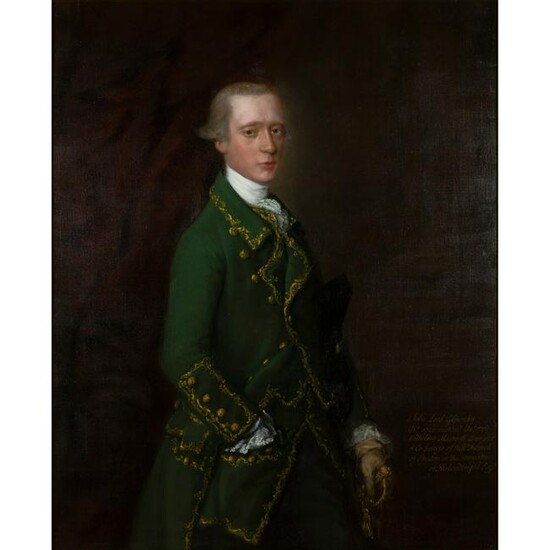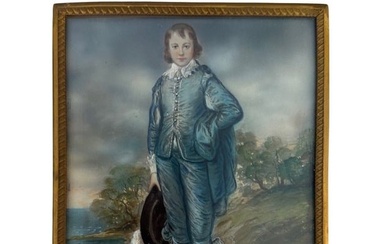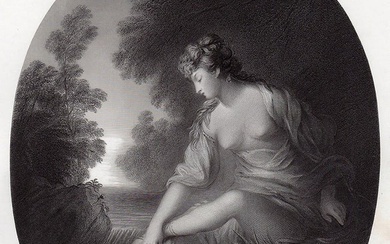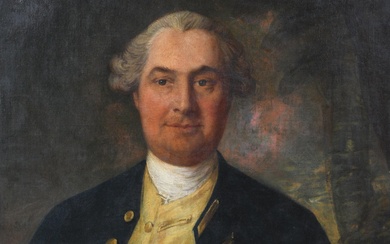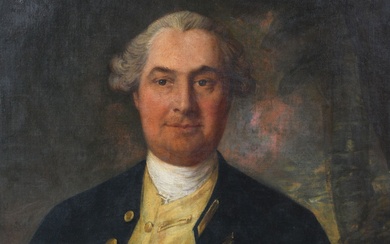â—† THOMAS GAINSBOROUGH R.A. (BRITISH 1717-1788)
Inscribed 'John Lord Glenorchy / Ano. 1762 married Ano. 1761 / Willielma Maxwell daughter / & Co-heiress of Willm. Maxwell / of Preston in the Stewartry / of Kirkcudbright Esqr.,' oil on canvas (Dimensions: 127cm x 101.6cm (50in x 40in))
(127cm x 101.6cm (50in x 40in))
Provenance: Commissioned by the sitter’s father, John Campbell, 3rd Earl of Breadalbane (died 1782); inherited by his distant kinsman, John, 4th Earl and 1st Marquess of Breadalbane, FRS. (1762-1834), Taymouth Castle, Perthshire; by descent to John, 2nd Marquess of Breadalbane KT, FRS, PSA, PBA (1796–1862); inherited by his elder sister, Lady Elizabeth Campbell (1794–1878), who in 1831 married as his second wife, Sir John Pringle, 5th Bt, Langton House, Duns; passed to her daughter, Mary (died 1911), who in 1861 married Major The Hon. Robert Baillie-Hamilton; passed to her sister, Magdalen (died 1913), who married in 1874 as her second husband Sir Robert Bateson Hervey, 1st Bt; inherited by her godson and first cousin twice removed, Lt Col. The Hon. Thomas Morgan-Grenville-Gavin (1891–1965), grandfather of the present owner.
Footnote: Literature: Hugh Belsey, Thomas Gainsborough: The Portraits, Fancy Pictures and Copies after Old Masters, New Haven and London 2019, vol. I, pp. 396–97, no. 400, repr. col. Note: The canvas is paired with a portrait of the sitter’s wife by Katherine Read. This painting was recorded in Christie Manson & Woods 1853 Inventory of Taymouth Castle as hanging in the Breakfast Room This recently identified portrait by Gainsborough is unusual. It is one of the few portraits dated by a receipt and the pendant portrait of his wife, is painted by another artist. Gainsborough’s portraits were famed for their likeness and in this particular portrait John, Lord Glenorchy, the heir of the Earl of Breadalbane, is shown as a slight, sickly figure. His elder brother, George, had died at the age of twelve in 1744 and tragically, in November 1771, Breadalbane’s second son, John, was to predecease him at the age of 33. In September 1761 John had married Wilhelmina Maxwell who later in life was to establish a number of dissenting chapels in Scotland and in south-west England. According to the Bath newspapers Lord and Lady Glenorchy travelled to Bath—no doubt to take the waters—in April 1762 and five months later Lord Glenorchy returned to the City without his wife. It must have been at the time of this second visit that Breadalbane commissioned Gainsborough to paint his son’s portrait. According to the Glenorchys’ friend Lord Royston, who was to sit to Gainsborough in May, the couple arrived in Bath on 9 April 1763, no doubt anxious to see the completed portrait. Breadalbane’s payment of £21.7s is recorded in a receipt dated 13 April 1763. It was customary for artists to be paid half the fee when the portrait was commissioned and the final payment was made once the portrait was finished. The receipt accords with the artist’s standard charge of £42 for a half-length portrait and the additional charge of 7s covered the cost of a packing case. Curiously, at the time Lord Glenorchy was sitting to Gainsborough in Bath, in London his wife was sitting for a pendant portrait by the Scottish painter and pastellist Katherine Read. A receipt for this canvas dated 22 April 1763 records the larger payment of £24.4s for the portrait which is presently lent to Dundee Museum and Art Gallery. There are very few instances of pendant portraits being commissioned from different artists. The portrait presently offered by Lyon & Turnbull was not the Glenorchys only connection with Gainsborough. In 1766, again for health reasons, Lady Glenorchy returned to Bath and sat to Gainsborough for a head-and-shoulders portrait in which she wears an elaborate brocaded green silk robe à la française. This portrait is now in a British private collection. No doubt seeking warmer climes again to improve their fragile health, later that year the couple travelled to the Continent arriving in Rome in November where they stayed until the summer of 1767. From June 1760 Gainsborough rented a house belonging to the Duke of Kingston that faced the west end of Bath Abbey. This prime location served him well and he quickly became an established part of the community. His ‘shew’ room, filled with portraits both completed and half finished, became one of the sights of the city; an added attraction for the ever-changing stream of tourists. Over the next three years Gainsborough received so many commissions that he suffered a serious breakdown in his health during the autumn of 1763 and his condition was considered grave enough for his death to be announced in the local newspapers. He had worked extraordinarily hard during the previous three years, developing his style from the provincial charm of his Suffolk portraits and by combining his innate draughtsmanship and honing his perfect colour harmonies he achieved his ambition to become an artist of national significance. His popularity grew exponentially and his appointments book, that must have included dates for Glenorchy’s and Royston’s sittings, was overflowing. Glenorchy wears clothes that are the height of fashion. His aile-de-pigeon bag-wig is set off by a fine worsted green suit with gold-covered buttons and gold-thread embroidery worked in a scroll design along the garment edges that is repeated on the cuffs and pocket flaps. The green suit is offset by a generous swag of red drapery in the background and, on the right, the appropriate grandeur of the sitter’s surroundings is suggested by a large column base. The portrait was recently cleaned to great effect and it shows the extraordinary dexterity in the artist’s handling of paint. Details such as the lace cuffs and the gloved right hand perfectly represent the comparative textures of linen and kidskin and demonstrate a relaxed fluency and confidence that is rare in any artist’s work. Compositionally the portrait is very close to another recently discovered portrait of James Edward Colleton (Belsey 199). With subtleties of stance and expression Gainsborough shows the divergent characters of the two sitters. Colleton, standing in a domestic interior, arrogantly confronts the beholder; his right arm held akimbo suggests the nervous irritation of being disturbed from reading a book. Glenorchy is more relaxed. His right hand is tucked into his waistcoat pocket and his gloved left hand rests on the hilt of a ceremonial sword. In contrast he has an expression of unruffled aristocratic sensibility. We are grateful to Hugh Belsey for his assistance in the cataloguing of this lot and his extensive background notes.
View it on
Estimate
Time, Location
Auction House
Inscribed 'John Lord Glenorchy / Ano. 1762 married Ano. 1761 / Willielma Maxwell daughter / & Co-heiress of Willm. Maxwell / of Preston in the Stewartry / of Kirkcudbright Esqr.,' oil on canvas (Dimensions: 127cm x 101.6cm (50in x 40in))
(127cm x 101.6cm (50in x 40in))
Provenance: Commissioned by the sitter’s father, John Campbell, 3rd Earl of Breadalbane (died 1782); inherited by his distant kinsman, John, 4th Earl and 1st Marquess of Breadalbane, FRS. (1762-1834), Taymouth Castle, Perthshire; by descent to John, 2nd Marquess of Breadalbane KT, FRS, PSA, PBA (1796–1862); inherited by his elder sister, Lady Elizabeth Campbell (1794–1878), who in 1831 married as his second wife, Sir John Pringle, 5th Bt, Langton House, Duns; passed to her daughter, Mary (died 1911), who in 1861 married Major The Hon. Robert Baillie-Hamilton; passed to her sister, Magdalen (died 1913), who married in 1874 as her second husband Sir Robert Bateson Hervey, 1st Bt; inherited by her godson and first cousin twice removed, Lt Col. The Hon. Thomas Morgan-Grenville-Gavin (1891–1965), grandfather of the present owner.
Footnote: Literature: Hugh Belsey, Thomas Gainsborough: The Portraits, Fancy Pictures and Copies after Old Masters, New Haven and London 2019, vol. I, pp. 396–97, no. 400, repr. col. Note: The canvas is paired with a portrait of the sitter’s wife by Katherine Read. This painting was recorded in Christie Manson & Woods 1853 Inventory of Taymouth Castle as hanging in the Breakfast Room This recently identified portrait by Gainsborough is unusual. It is one of the few portraits dated by a receipt and the pendant portrait of his wife, is painted by another artist. Gainsborough’s portraits were famed for their likeness and in this particular portrait John, Lord Glenorchy, the heir of the Earl of Breadalbane, is shown as a slight, sickly figure. His elder brother, George, had died at the age of twelve in 1744 and tragically, in November 1771, Breadalbane’s second son, John, was to predecease him at the age of 33. In September 1761 John had married Wilhelmina Maxwell who later in life was to establish a number of dissenting chapels in Scotland and in south-west England. According to the Bath newspapers Lord and Lady Glenorchy travelled to Bath—no doubt to take the waters—in April 1762 and five months later Lord Glenorchy returned to the City without his wife. It must have been at the time of this second visit that Breadalbane commissioned Gainsborough to paint his son’s portrait. According to the Glenorchys’ friend Lord Royston, who was to sit to Gainsborough in May, the couple arrived in Bath on 9 April 1763, no doubt anxious to see the completed portrait. Breadalbane’s payment of £21.7s is recorded in a receipt dated 13 April 1763. It was customary for artists to be paid half the fee when the portrait was commissioned and the final payment was made once the portrait was finished. The receipt accords with the artist’s standard charge of £42 for a half-length portrait and the additional charge of 7s covered the cost of a packing case. Curiously, at the time Lord Glenorchy was sitting to Gainsborough in Bath, in London his wife was sitting for a pendant portrait by the Scottish painter and pastellist Katherine Read. A receipt for this canvas dated 22 April 1763 records the larger payment of £24.4s for the portrait which is presently lent to Dundee Museum and Art Gallery. There are very few instances of pendant portraits being commissioned from different artists. The portrait presently offered by Lyon & Turnbull was not the Glenorchys only connection with Gainsborough. In 1766, again for health reasons, Lady Glenorchy returned to Bath and sat to Gainsborough for a head-and-shoulders portrait in which she wears an elaborate brocaded green silk robe à la française. This portrait is now in a British private collection. No doubt seeking warmer climes again to improve their fragile health, later that year the couple travelled to the Continent arriving in Rome in November where they stayed until the summer of 1767. From June 1760 Gainsborough rented a house belonging to the Duke of Kingston that faced the west end of Bath Abbey. This prime location served him well and he quickly became an established part of the community. His ‘shew’ room, filled with portraits both completed and half finished, became one of the sights of the city; an added attraction for the ever-changing stream of tourists. Over the next three years Gainsborough received so many commissions that he suffered a serious breakdown in his health during the autumn of 1763 and his condition was considered grave enough for his death to be announced in the local newspapers. He had worked extraordinarily hard during the previous three years, developing his style from the provincial charm of his Suffolk portraits and by combining his innate draughtsmanship and honing his perfect colour harmonies he achieved his ambition to become an artist of national significance. His popularity grew exponentially and his appointments book, that must have included dates for Glenorchy’s and Royston’s sittings, was overflowing. Glenorchy wears clothes that are the height of fashion. His aile-de-pigeon bag-wig is set off by a fine worsted green suit with gold-covered buttons and gold-thread embroidery worked in a scroll design along the garment edges that is repeated on the cuffs and pocket flaps. The green suit is offset by a generous swag of red drapery in the background and, on the right, the appropriate grandeur of the sitter’s surroundings is suggested by a large column base. The portrait was recently cleaned to great effect and it shows the extraordinary dexterity in the artist’s handling of paint. Details such as the lace cuffs and the gloved right hand perfectly represent the comparative textures of linen and kidskin and demonstrate a relaxed fluency and confidence that is rare in any artist’s work. Compositionally the portrait is very close to another recently discovered portrait of James Edward Colleton (Belsey 199). With subtleties of stance and expression Gainsborough shows the divergent characters of the two sitters. Colleton, standing in a domestic interior, arrogantly confronts the beholder; his right arm held akimbo suggests the nervous irritation of being disturbed from reading a book. Glenorchy is more relaxed. His right hand is tucked into his waistcoat pocket and his gloved left hand rests on the hilt of a ceremonial sword. In contrast he has an expression of unruffled aristocratic sensibility. We are grateful to Hugh Belsey for his assistance in the cataloguing of this lot and his extensive background notes.
